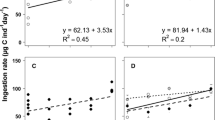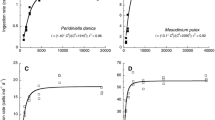Abstract.
The effect of temperature and viscosity on the ingestion rate of Daphnia galeata and Chydorus sphaericus was investigated in short-term feeding experiments with 3H-labelled Scenedesmus quadricauda. Viscosity was manipulated independently from temperature by addition of inert polymers in two experiments. In the first experiment, the ingestion rate of D. galeata was found to be 50% lower at 10°C than at 25°C due to the combined effects of increased viscosity and lower temperature. Viscosity alone accounted for 61% of the decline in ingestion rate. In the second experiment, the ingestion rate of a different clone of D. galeata was 46–53% lower at 10°C than at 20°C and changes in viscosity alone accounted for most (>92%) of that decline. The ingestion rate of C. sphaericus was 80% lower at 10°C than at 20°C, and viscosity accounted for 65% of that decline. Thus, viscosity plays an important role in determining the ingestion rate of crustacean zooplankton. Adaptations to life in waters that undergo considerable variation in temperature and viscosity may therefore influence energy budgets and may eventually be of importance for zooplankton species succession, distribution and evolution.
Similar content being viewed by others
Author information
Authors and Affiliations
Corresponding author
Additional information
Received: 25 March 2003; revised manuscript accepted: 2 October 2003
Rights and permissions
About this article
Cite this article
Loiterton, B., Sundbom, M. & Vrede, T. Separating physical and physiological effects of temperature on zooplankton feeding rate. Aquat. Sci. 66, 123–129 (2004). https://doi.org/10.1007/s00027-003-0668-3
Issue Date:
DOI: https://doi.org/10.1007/s00027-003-0668-3




